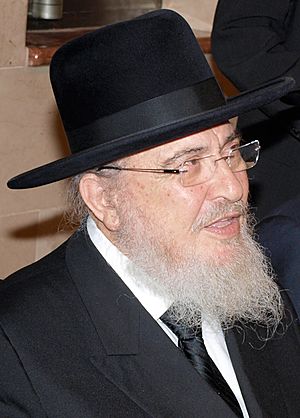Baruch Mordechai Ezrachi facts for kids
Quick facts for kids Baruch Mordechai Ezrachiברוך מרדכי אזרחי |
|
|---|---|
 |
|
| Religion | Judaism |
| Alma mater | Hebron Yeshiva |
| Personal | |
| Nationality | Israeli |
| Born | 27 March 1929 Petah Tikva, Mandatory Palestine |
| Died | 26 October 2023 (aged 94) Jerusalem, Israel |
| Spouse | Shulamit Ezrachi |
| Senior posting | |
| Title | Rosh Yeshiva |
| Position | Rosh Yeshiva |
| Yeshiva | Ateres Yisrael |
| Other | Member of the Moetzes Gedolei HaTorah |
Baruch Mordechai Ezrachi (born March 27, 1929 – died October 26, 2023) was an important Haredi rabbi in Israel. He was a respected leader among Lithuanian Jews, who are a group of non-Hasidic Jews. He served as the Rosh Yeshiva, or head, of the Ateres Yisrael yeshiva in Jerusalem. He was also a member of the Moetzes Gedolei HaTorah, a group of leading rabbis.
Rav Ezrachi was the son-in-law of Rabbi Meir Chodosh. Rabbi Chodosh was a mashgiach ruchani, a spiritual guide, at the Hebron Yeshiva. In 1976, Rav Ezrachi started his own yeshiva, Ateres Yisrael, in Jerusalem. Later, in 1979, he moved the yeshiva to Modi'in.
Even though he studied at the Hebron Yeshiva, Rav Ezrachi saw himself as a student of Rav Dovid Soloveitchik. Rav Soloveitchik was seven years older than him. Rav Baruch Mordechai Ezrachi passed away on October 26, 2023, at the age of 94. His brother, Rav Yitzchok Ezrachi, is also a Rosh Yeshiva at the Mir Yeshiva in Jerusalem.
What Did Rav Ezrachi Write?
Rav Ezrachi wrote many books of commentary. These books covered different Jewish topics. They included the Torah (Jewish holy texts), the Talmud (Jewish law and tradition), halacha (Jewish law), and Jewish festivals. His collection of writings is called Birkas Mordechai. In Hebrew, this means Blessings of Mordechai.
How Did Rav Ezrachi Teach?
Rav Ezrachi had a special way of teaching. He followed the traditional methods of the Hebron Yeshiva. He did not use the Brisker method, even though he admired Rav Dovid Soloveitchik. Instead, he focused on carefully studying and comparing different Talmudic texts.
His teaching involved asking challenging questions about the texts. These questions would make students think deeply. Then, he would help them find the answers by re-explaining the text. This method helped students truly understand the material.

